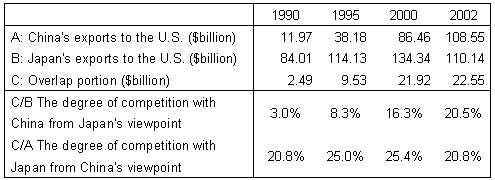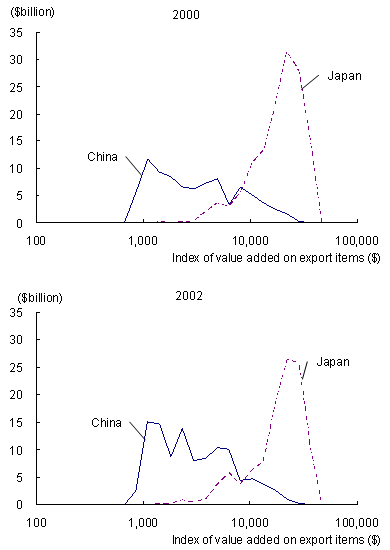The remarkable economic development experienced by China in the 1990s, thanks to its market-opening reforms, has continued beyond 2000 with the country maintaining a high growth of 7 to 8% and joining the World Trade Organization in December 2001. The value of China's total exports in 2002 was 30% greater than in 2000, and in 2002 it became No. 1 in the world in terms of inflow of foreign direct investment. As China's economy grows, Chinese companies are expanding their export competitiveness and have begun exporting high value-added products such as information technology-related goods, leading to what I call "Japan's China Syndrome" - concerns that these companies threaten the export competitiveness of Japanese firms. As we have pointed out in this column, based on 2000 data, China and Japan are in a complementary relationship rather than a competitive one, since China specializes in low value-added goods while Japan focuses on high value-added products. How has this situation changed since then? Here I will look into the subsequent changes in the complementary and competitive relationships between Japan and China using the 2002 import statistics of the United States.
First, let me explain the framework I used for my analysis. When commodities are lined up from left to right in order of how high-tech they are, the exports of Japan and China each form one distribution. The size of the distribution is proportionate to the scale of the country's exports, and the further to the right it is on the chart, the more advanced its export structure is. The larger the area in which China's distribution overlaps with Japan's the more China is competing with Japan, and the smaller the overlap the more complementary the relationship is. Over time, the complementary and competitive relationship between the two nations changes with the size and position of their respective distributions. Specifically, from Japan's point of view, the extent to which it competes with China increases with the growth in China's exports and the advancement of its industrial structure, and falls with a rise in Japan's exports and its own industrial progress.
Based on the framework and using U.S. import statistics, we show that in the U.S. market, the extent to which Japan's products competed with those from China rose from 16.3% in 2000 to 20.5% in 2002 (see chart and diagram). This mainly reflects the fact that while the scale of China's exports rose, Japan's contracted. Moreover, at present, the distributions that show the export structures of the two countries remain apart, and there is still a clear division of labor whereby Japan exports high value-added products while China ships mid and low value-added goods. In the area of high-tech products, there is almost no competition between Japan and China, and there is no change to the past pattern of Japan holding a much greater advantage.
However, in the future, China will likely shift the distribution of its export structure and begin to export products with an even higher value added, while further expanding its exports. If Japan attempts to protect industries dealing in mid to low value-added goods that are in a competitive relationship with China, it would hold back the advancement of its domestic industrial structure and further increase the areas in which it competes with China. Such policies are not beneficial for either Japan or China. The strategy Japan should take, both for its own benefit as well as that of other countries, is not to try to stop the countries that are catching up from behind, but to move further ahead. By doing so, the complementary relationship between Japan and China will be maintained and both parties will be able to benefit greatly through trading with each other.


Source: Based on U.S. import statistics


